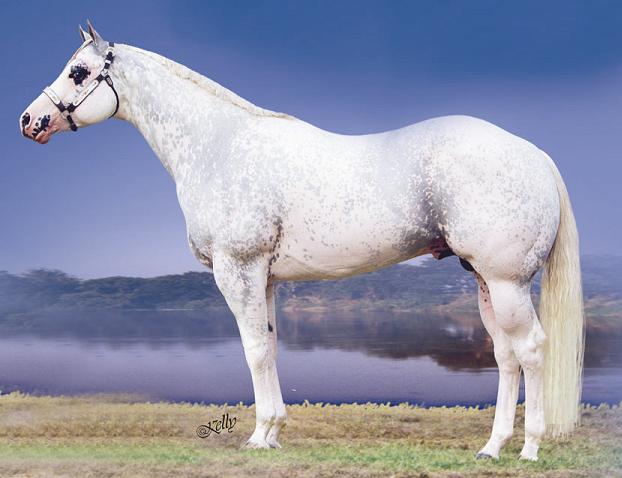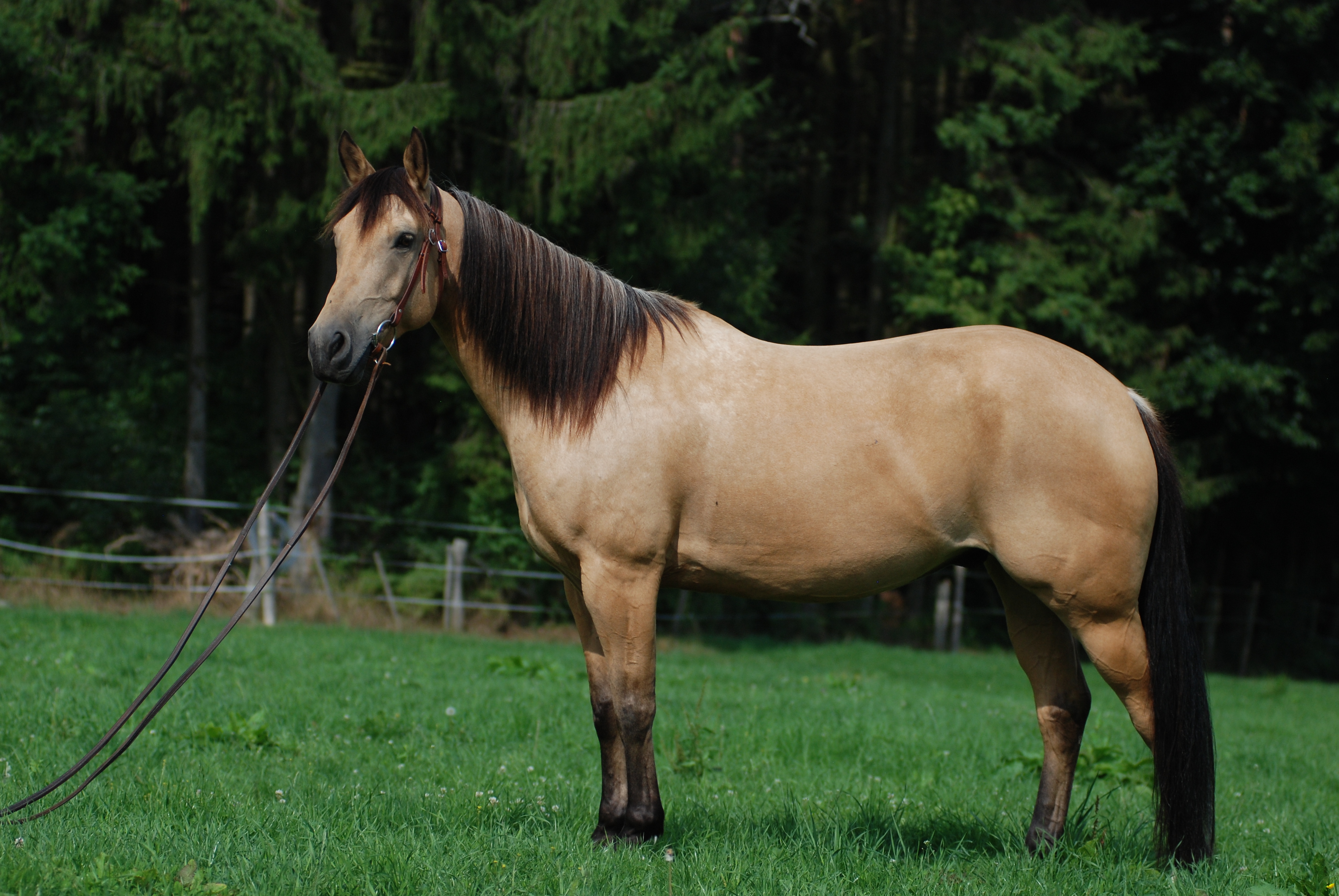Quarter Horse Definition
The early improvement in the Quarter Horse-so called because of its great speed at one quarter of a mile-and the early development of the Thoroughbred in the United States were closely associated. Some sires contributed notably to both breeds. Many short-distance horses were registered in the American Stud Book as Thoroughbreds when the Stud Book was established, even though they did not trace in all lines to imported English stock.
It is more logical to assume that the true establishment of the Quarter Horse took place some time later in the southwest range country, rather than in colonial times. It was in the southwest that the true utility value of these short-distance horses were truly appreciated. The cowman found the Quarter Horse quick to start, easy to handle, and of a temperament suitable for handling cattle under a wide variety of conditions. Even in the Southwest much was unknown of the breeding of many of the horses that were classified and registered in the 1940s as Quarter Horses. It is logical, therefore, to conclude that until the Stud Book was established and the pedigrees were based on fact rather than on memory and assumptions, the Quarter Horse should have been called a type of horse rather than a breed.
The Foundation and Improvement of the Breed
A Blending of Bloodlines. It is difficult to give the exact origin of the present-day Quarter Horse because the blending of bloodlines produce a suitable short-distance horse started in colonial areas prior to the Revolutionary War. This blending of bloodlines and the infusion of Thoroughbred blood was continued in the southwestern range territory as the cow country developed. Cowboys wanted to be well mounted. Ranchers tried to breed the kind of horses on which these men could work cattle and that could also be used in the age-old sport of racing. The Quarter Horse was not raced on carefully prepared tracks but was raced on any suitable open space. Organized races were the exception rather than the rule with many of the races being run as a “match race” after a private wager between owner or riders.
In the Southwest country as in the East, no particular attention was made to keep short-distance horses as a distinct breed. Fast horses whose offspring made good cow ponies were crossed on existing stock of mares. Many times these mares carried Spanish, Arabian, Morgan, or Standardbred breeding, and some have been referred to as “cold blooded” mares. The naming of horses after persons was a common practice, and often when the horses were sold their names were changed; such practices have led to no end of confusion in attempting to verify pedigrees after the horses, breeders, and owners were deceased.
The Contribution of Steel Dust. The first horse of Quarter type that attracted a great deal of attention in the Southwest was Steel Dust, foaled in Illinois in 1843, and taken to Lancaster, Texas, in 1846. He was a blood bay that stood 15 hands high and weighed approximately 1,200 pounds. Steel Dust was sired by Harry Bluff and traced to Sir Archy. The popularity of Steel Dust as a running horse and as a sire of running horses and cow horses caused many horses that descended from him, or were of similar type, to be called “Steel Dust” horses2. This name was quite common until the American Quarter Horse Association was established and the name Quarter Horse was officially adopted.










Source(Google.com)
The principle development of the Quarter Horse was in the southwestern part of the United States in Texas, Oklahoma, New Mexico, eastern Colorado, and Kansas. Some breed historians have maintained that it is the oldest breed of horses in the United States and that the true beginning of the Quarter Horse was in the Carolinas and Virginia. Nye1 has suggested that the Chickasaws secured from the Indians were the true beginning of the Quarter Horse. These were small blocky horses, probably of Spanish extraction, which the planters secured from the Indians, and which were adapted for a variety of uses. The colonists were quite interested in short races, and it was only natural that they should have attempted to increase the speed of their horses; to this end some of the best early Thoroughbreds that were brought to the United States included the horse Janus, brought to the United States before the English Stud Book was established, were instrumental in the improvement of these local running horse. Later Imp. Sir Archy and other Thoroughbred stallions were used.
The early improvement in the Quarter Horse-so called because of its great speed at one quarter of a mile-and the early development of the Thoroughbred in the United States were closely associated. Some sires contributed notably to both breeds. Many short-distance horses were registered in the American Stud Book as Thoroughbreds when the Stud Book was established, even though they did not trace in all lines to imported English stock.
It is more logical to assume that the true establishment of the Quarter Horse took place some time later in the southwest range country, rather than in colonial times. It was in the southwest that the true utility value of these short-distance horses were truly appreciated. The cowman found the Quarter Horse quick to start, easy to handle, and of a temperament suitable for handling cattle under a wide variety of conditions. Even in the Southwest much was unknown of the breeding of many of the horses that were classified and registered in the 1940s as Quarter Horses. It is logical, therefore, to conclude that until the Stud Book was established and the pedigrees were based on fact rather than on memory and assumptions, the Quarter Horse should have been called a type of horse rather than a breed.
The Foundation and Improvement of the Breed
A Blending of Bloodlines. It is difficult to give the exact origin of the present-day Quarter Horse because the blending of bloodlines produce a suitable short-distance horse started in colonial areas prior to the Revolutionary War. This blending of bloodlines and the infusion of Thoroughbred blood was continued in the southwestern range territory as the cow country developed. Cowboys wanted to be well mounted. Ranchers tried to breed the kind of horses on which these men could work cattle and that could also be used in the age-old sport of racing. The Quarter Horse was not raced on carefully prepared tracks but was raced on any suitable open space. Organized races were the exception rather than the rule with many of the races being run as a “match race” after a private wager between owner or riders.
In the Southwest country as in the East, no particular attention was made to keep short-distance horses as a distinct breed. Fast horses whose offspring made good cow ponies were crossed on existing stock of mares. Many times these mares carried Spanish, Arabian, Morgan, or Standardbred breeding, and some have been referred to as “cold blooded” mares. The naming of horses after persons was a common practice, and often when the horses were sold their names were changed; such practices have led to no end of confusion in attempting to verify pedigrees after the horses, breeders, and owners were deceased.
The Contribution of Steel Dust. The first horse of Quarter type that attracted a great deal of attention in the Southwest was Steel Dust, foaled in Illinois in 1843, and taken to Lancaster, Texas, in 1846. He was a blood bay that stood 15 hands high and weighed approximately 1,200 pounds. Steel Dust was sired by Harry Bluff and traced to Sir Archy. The popularity of Steel Dust as a running horse and as a sire of running horses and cow horses caused many horses that descended from him, or were of similar type, to be called “Steel Dust” horses2. This name was quite common until the American Quarter Horse Association was established and the name Quarter Horse was officially adopted.
Quarter Horses Images Wallpapers Photos 2013

Quarter Horses Images Wallpapers Photos 2013

Images Wallpapers Photos 2013

Quarter Horses Images Wallpapers Photos 2013

Quarter Horses Images Wallpapers Photos 2013
Images Wallpapers Photos 2013

Images Wallpapers Photos 2013

Images Wallpapers Photos 2013

Images Wallpapers Photos 2013

Images Wallpapers Photos 2013
Images Wallpapers Photos 2013
No comments:
Post a Comment